Do you have a question about the Weber Spirit E210 and is the answer not in the manual?
Procedure to follow in case of gas leak detection. Includes shutting off gas and extinguishing flames.
Precautions regarding flammable liquids, LP cylinder storage, and outdoor use.
Instructions for installers to leave manual with owner for future use.
Warnings about improper assembly, unattended use, and hot surfaces.
Cautions on fuel storage, specific materials, and burner operation.
State-specific warnings regarding combustion byproducts and lead exposure.
Specific durations for parts like aluminum castings, shrouds, burners, grates, and other components.
Conditions not covered, such as accident, abuse, misuse, and weather damage.
Detailed list of all components for the SPIRIT E210 LP grill with part numbers.
Detailed list of all components for the SPIRIT E310 LP grill with part numbers.
Detailed list of all components for the SPIRIT SP310 LP grill with part numbers.
Explanation of propane's properties, odor, and behavior as fuel.
Essential safety guidelines for handling, transporting, and using propane cylinders.
Procedures for storing the grill and LP cylinder when not in use.
Compliance with installation codes and specifications for LP cylinders in US and Canada.
Explanation of the regulator's function in controlling gas pressure.
Details on connecting the regulator and hose assembly to the LP cylinder.
Guidance on obtaining LP cylinders and the process of installing one into the grill.
Steps for securely connecting the gas regulator and hose assembly to the cylinder valve.
How to read the cylinder scale to determine the amount of propane remaining.
Step-by-step instructions for safely removing the LP cylinder for refilling or exchange.
Guidelines and safety warnings for refilling LP gas cylinders, emphasizing authorized dealers.
Introduction to leak checks and initial disassembly steps.
Critical warnings regarding outdoor use, clearance, and combustible materials.
Detailed steps for applying soap solution to connections and identifying leaks.
Steps to reassemble the control panel after leak checking.
Advice on preheating, cooking times, food preparation, and using utensils.
Information on preheating, covered cooking, and the Flavorizer® system.
Instructions for managing drippings and grease, including slide-out tray use.
Procedures for cleaning the slide-out grease tray and catch pan to prevent fires.
Guide on inspecting the gas hose for damage like cracks or cuts before each use.
Step-by-step guide for igniting burner 1 using the electronic system, including safety warnings.
Instructions on how to properly turn off the burners and gas supply.
Detailed steps for igniting the main burner using a match and matchstick holder.
Solutions for burners not igniting or having weak flames.
Guidance on erratic flames, low heat, yellow flames, and flare-ups.
Troubleshooting advice for grease tray lining and lid appearance.
How to assess the burner flame pattern and identify potential issues.
Importance of cleaning or replacing screens to prevent burner obstruction.
Methods to determine and address blocked burner tube ports for optimal gas flow.
Procedure to follow in case of gas leak detection. Includes shutting off gas and extinguishing flames.
Precautions regarding flammable liquids, LP cylinder storage, and outdoor use.
Instructions for installers to leave manual with owner for future use.
Warnings about improper assembly, unattended use, and hot surfaces.
Cautions on fuel storage, specific materials, and burner operation.
State-specific warnings regarding combustion byproducts and lead exposure.
Specific durations for parts like aluminum castings, shrouds, burners, grates, and other components.
Conditions not covered, such as accident, abuse, misuse, and weather damage.
Detailed list of all components for the SPIRIT E210 LP grill with part numbers.
Detailed list of all components for the SPIRIT E310 LP grill with part numbers.
Detailed list of all components for the SPIRIT SP310 LP grill with part numbers.
Explanation of propane's properties, odor, and behavior as fuel.
Essential safety guidelines for handling, transporting, and using propane cylinders.
Procedures for storing the grill and LP cylinder when not in use.
Compliance with installation codes and specifications for LP cylinders in US and Canada.
Explanation of the regulator's function in controlling gas pressure.
Details on connecting the regulator and hose assembly to the LP cylinder.
Guidance on obtaining LP cylinders and the process of installing one into the grill.
Steps for securely connecting the gas regulator and hose assembly to the cylinder valve.
How to read the cylinder scale to determine the amount of propane remaining.
Step-by-step instructions for safely removing the LP cylinder for refilling or exchange.
Guidelines and safety warnings for refilling LP gas cylinders, emphasizing authorized dealers.
Introduction to leak checks and initial disassembly steps.
Critical warnings regarding outdoor use, clearance, and combustible materials.
Detailed steps for applying soap solution to connections and identifying leaks.
Steps to reassemble the control panel after leak checking.
Advice on preheating, cooking times, food preparation, and using utensils.
Information on preheating, covered cooking, and the Flavorizer® system.
Instructions for managing drippings and grease, including slide-out tray use.
Procedures for cleaning the slide-out grease tray and catch pan to prevent fires.
Guide on inspecting the gas hose for damage like cracks or cuts before each use.
Step-by-step guide for igniting burner 1 using the electronic system, including safety warnings.
Instructions on how to properly turn off the burners and gas supply.
Detailed steps for igniting the main burner using a match and matchstick holder.
Solutions for burners not igniting or having weak flames.
Guidance on erratic flames, low heat, yellow flames, and flare-ups.
Troubleshooting advice for grease tray lining and lid appearance.
How to assess the burner flame pattern and identify potential issues.
Importance of cleaning or replacing screens to prevent burner obstruction.
Methods to determine and address blocked burner tube ports for optimal gas flow.
| Main Burners | 2 |
|---|---|
| Total Cooking Area | 450 sq in |
| Primary Cooking Area | 360 sq in |
| Warming Rack Area | 90 sq in |
| BTU-per-hour Input | 26, 500 |
| Dimensions - Lid Open | 63" H x 50" W x 32" D |
| Dimensions - Lid Closed | 45.5" H x 50" W x 24" D |
| Fuel Type | Liquid Propane |
| Grill Material | Porcelain-enameled cast-iron cooking grates |
| Ignition System | Electronic Crossover |
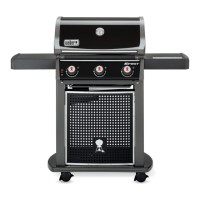
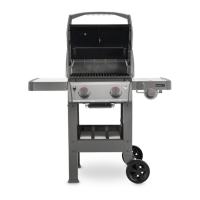
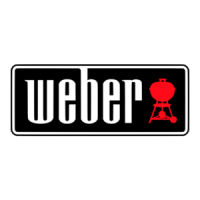
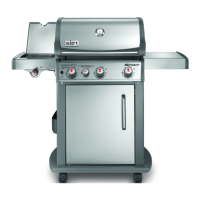
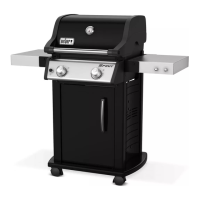


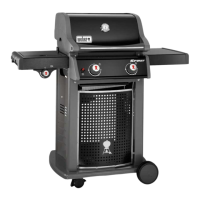
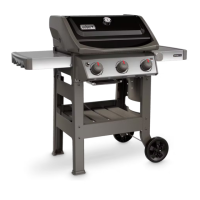
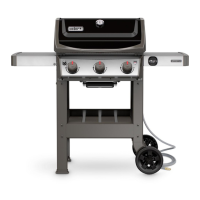
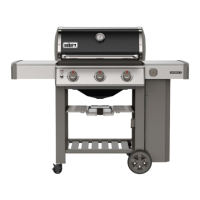

